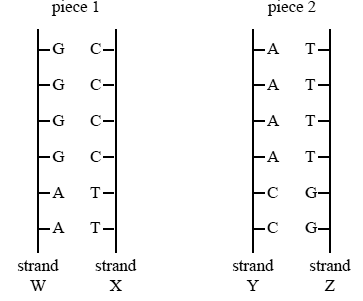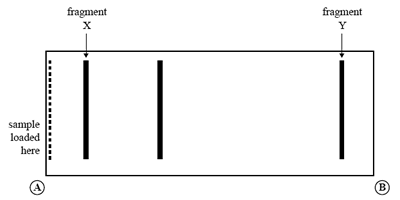Bio-macro molecules chemistry 2008 VCE
A biomolecule is chemically analysed and found to contain only the elements carbon, hydrogen, oxygen,
nitrogen and phosphorus.
The biomolecule is most likely to be
A. DNA.
B. a protein.
C. a polysaccharide.
D. a fat formed by condensation of glycerol with stearic acid.

A piece of double-stranded DNA, which is 200 base pairs in length, contains 50 thymine bases.
The number of guanine bases in the piece of DNA is
A. 50
B. 100
C. 125
D. 150
Solution

In the pieces of double-stranded DNA shown below, the letters A, C, G and T represent the bases adenine,
cytosine, guanine and thymine respectively. Each vertical line represents a sugar-phosphate backbone.

Which one of the following alternatives correctly identifies the DNA piece that is most readily separated by heating and the strand of highest molecular mass?
piece most readily strand of highest
separated by heating molecular mass
A. 1 is the piece most readily separated and X has the highest molecular mass.
B. 2 is the piece most readily separated and W has the highest molecular mass
C. 2 is the piece most readily separated and X has the highest molecular mass
D. 1 is the piece most readily separated and W has the highest molecular mass
Solution

Gel electrophoresis is a technique that can be used to separate DNA fragments in forensic chemistry. The gel
resulting from such a separation experiment carried out at pH 7 is shown below.

Which one of the following statements about the experiment is not correct?
A. Fragment X has a higher molecular mass than fragment Y.
B. Fragment Y moves through the gel at a faster rate than fragment X.
C. The negative terminal of the power supply is connected to end A of the gel.
D. Under the conditions of this experiment, the DNA fragments are positively charged.
Solution

Draw the structure, showing all bonds, of the amino acid serine as it would exist in solution at pH 2.
Solution
Name the functional group on the side chain of serine.
Solution
Write the molecular formula of the amino acid phenylalanine.
Solution
Two different dipeptides can form between phenylalanine and serine.
Draw the structure of one of these dipeptides and circle the peptide (amide) functional group in the dipeptide you have drawn in the question above.
Solution
The tertiary structure of a protein is maintained by interactions between the side chains of amino acid residues.
One such interaction is between cysteine residues.
Sketch a covalent link that can form between the side chains of two cysteine residues. Only the relevant atoms that form the link need to be shown.
Solution
